Red light therapy supercharges your cells' power plants – the mitochondria – in seven key ways. It activates cytochrome c oxidase to amplify ATP production, enhances your electron transport chain's efficiency, and strengthens mitochondrial membrane function by up to 20%. You'll benefit from increased nitric oxide release, which improves blood flow and oxygen delivery to cells. The therapy optimizes cellular energy metabolism, strengthens your natural antioxidant defenses, and promotes mitochondrial biogenesis for more energy producers. Discover how these molecular mechanisms can revolutionize your cellular health and energy from the inside out.
Nitric Oxide Release
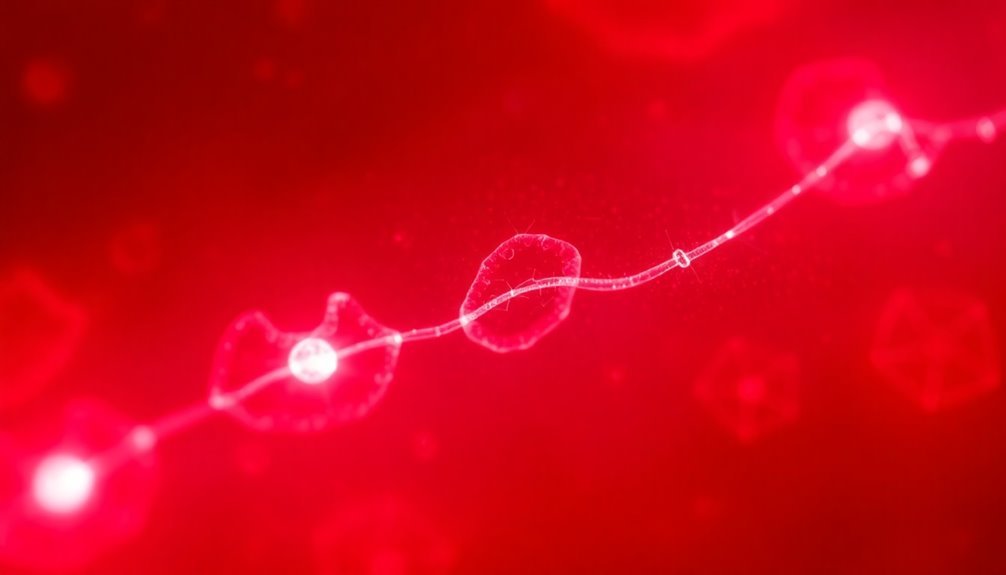
Red and near-infrared light kicks off an essential biological process by triggering the release of nitric oxide (NO) from cells. When light wavelengths between 600-940 nm hit your cells, they interact with cytochrome c oxidase, liberating NO and enabling your cells to produce more ATP – your body's primary energy source. The science behind this process was first validated through Finsen's pioneering work, which earned him the 1903 Nobel Prize in Medicine.
You'll experience multiple benefits from this NO release. As NO causes your blood vessels to dilate, you'll get improved circulation and lower blood pressure. This enhanced blood flow delivers more oxygen and nutrients to your tissues, supporting faster healing and repair.
The anti-inflammatory properties of NO help reduce pain and swelling, making it particularly effective for conditions like arthritis. Your immune system also gets a boost from NO release, helping your body fight infections more effectively.
If you're dealing with skin issues, you'll find that NO promotes collagen production and skin elasticity, improving your complexion. For muscle recovery, the increased blood flow and tissue repair capabilities mean you'll bounce back faster from workouts.
While individual responses vary, you can maximize these benefits by following proper treatment protocols and consulting with healthcare professionals about your specific needs.
ATP Production Pathways
When light wavelengths between 600-1000 nm reach your mitochondria, they set off a remarkable chain of events that supercharges your cells' energy production. The light excites electrons in your electron transport chain, enhancing the efficiency of NADH and FADH2 carriers. This process creates a stronger proton gradient across your mitochondrial membrane, which powers ATP synthase more effectively.
Your mitochondria respond to red and near-infrared light by increasing their ATP production while reducing harmful reactive oxygen species. The light reduces the viscosity of water layers inside your mitochondria, helping ATP synthase work more efficiently. You'll get the best results with wavelengths between 780-830 nm, as these penetrate deeper into your tissues. The citric acid cycle works alongside these processes to harvest additional high-energy electrons for ATP production.
Through photobiomodulation, your cells convert this light energy directly into chemical energy in the form of ATP. The process works like a molecular power plant, where light energy stimulates your cellular respiratory chain to produce more ATP from ADP and Pi.
This enhanced energy production supports tissue repair, reduces inflammation, and powers various cellular processes that keep your body functioning at its best.
Cytochrome C Oxidase Activation
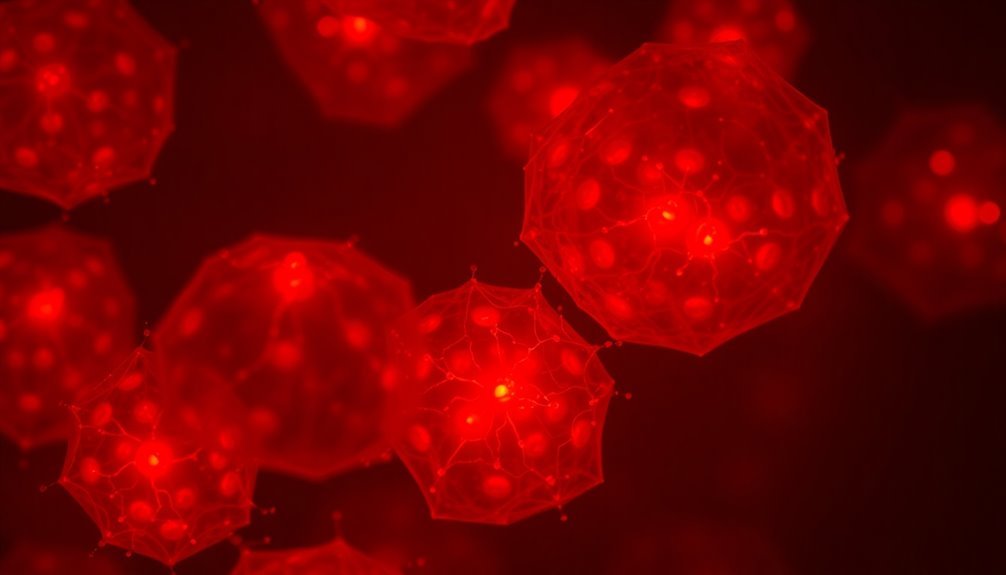
Cytochrome C oxidase (CCO), an essential enzyme in your mitochondrial membrane, serves as the primary photoacceptor for red and near-infrared light therapy. When specific wavelengths between 600-810 nm hit your cells, they activate CCO, triggering a cascade of beneficial effects in your cellular energy production.
This activation works through multiple mechanisms. Red light helps change the redox state of enzymes in your mitochondrial membrane, boosting energy metabolism. It's particularly effective at 632 nm, where it improves oxygen consumption and cytochrome c oxidation. The formation of cAMP occurs as a crucial step in this cellular signaling process.
The process also involves nitric oxide (NO), which plays a vital role in how photobiomodulation affects CCO. As light intensity increases, so does NO synthesis, especially under low oxygen conditions.
Different wavelengths offer unique benefits: 620 and 760 nm promote neurite growth, while 810 nm enhances oxidative energy metabolism.
When CCO gets activated, you'll experience improved ATP production and enhanced cellular energy. This is especially important as you age, since chronic laser stimulation can reverse age-related decline in CCO activity, ultimately improving your brain function and overall cellular health.
Electron Transport Chain Enhancement
Light therapy's impact on cellular energy extends deep into your mitochondria's electron transport chain, where it greatly enhances ATP production.
When red light interacts with cytochrome c oxidase, it displaces nitric oxide and optimizes electron flow, leading to more efficient energy production in your cells. Studies show that red wavelengths 610-640nm are particularly effective for this process.
You'll benefit from improved mitochondrial function in several ways. The enhanced electron transport chain activity reduces the leakage of harmful reactive oxygen species, lowering oxidative stress in your cells.
Specific wavelengths, particularly 850 nm and 940 nm, stimulate the respiration of mitochondrial complexes, boosting your cellular energy production.
Red light therapy doesn't just improve existing mitochondria – it also triggers the creation of new ones. This process, called mitochondrial biogenesis, increases your cells' energy-producing capacity and their resistance to stress.
As your mitochondrial numbers grow, you'll experience better overall cellular function and reduced oxidative damage.
The therapy's effects on your electron transport chain create a cascade of benefits: more efficient ATP production, reduced oxidative stress, and increased mitochondrial numbers.
Together, these improvements support your cells' energy production and overall health.
Mitochondrial Membrane Function
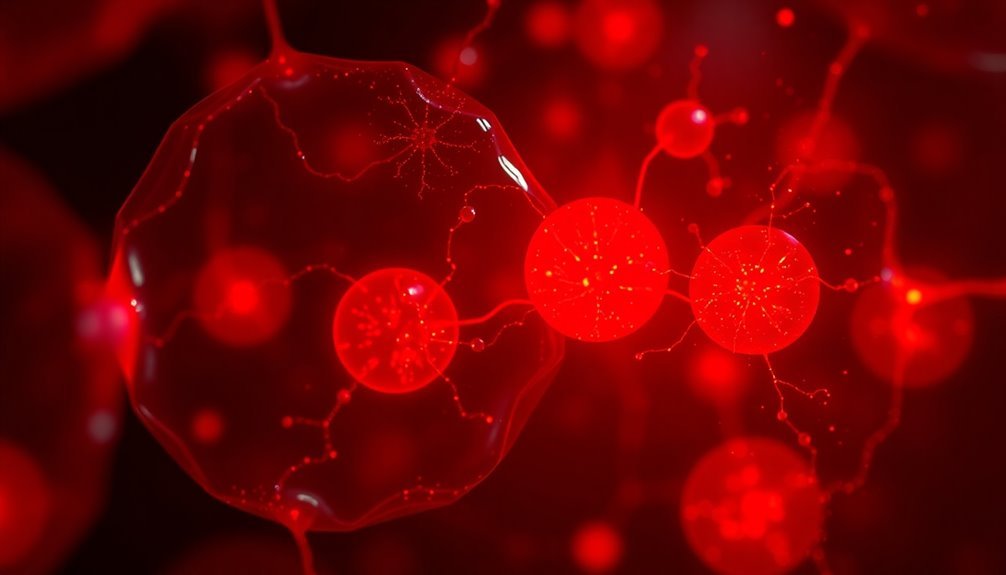
During red light therapy, your mitochondrial membranes undergo significant changes that boost their energy-producing potential. When red light hits your cells, it directly enhances the membrane potential of your mitochondria – the powerhouses that generate your cellular energy.
You'll benefit from up to 20% increased membrane potential, which translates to higher energy production in your cells. Research shows that 5 to 10 minutes of red light exposure provides optimal membrane potential enhancement.
Your mitochondrial membranes respond to red light through specific mechanisms involving cytochrome C oxidase, a vital component of the electron transport chain. This interaction leads to improved oxygen consumption and enhanced energy production.
You can think of it as upgrading your cellular batteries to hold and produce more power.
Here's what happens to your mitochondrial membranes during red light therapy:
- The membrane potential increases, allowing for more efficient energy production
- The electron transport chain functions more effectively, improving oxygen utilization
- The membrane dynamics shift to optimize energy generation and cellular function
These membrane-level changes aren't just temporary – with consistent exposure to red light therapy, you can experience cumulative benefits that support your cellular health and energy production over time.
Cellular Energy Metabolism
You'll find that red light therapy naturally enhances your cells' energy production by stimulating the mitochondria to create more ATP through the citric acid cycle.
Your cellular metabolism gets a significant boost when red light breaks nitric oxide bonds, allowing hydrogen ions to move more efficiently through the electron transport chain.
This increased mitochondrial efficiency leads to higher ATP levels, giving your cells the energy they need to function at their best. The therapy's use of specific wavelengths between 600-1100 nm ensures optimal penetration into cellular tissues.
ATP Production Process
Cells throughout your body depend on a complex network of metabolic pathways to generate ATP (adenosine triphosphate), the primary energy currency of life. Your cells produce ATP through several interconnected processes, with oxidative phosphorylation being the most efficient. This process relies on the electron transport chain in your mitochondria, which creates a proton gradient that drives ATP synthesis. A well-regulated ATP turnover rate helps maintain optimal energy levels in your cells.
The ATP production process follows these key steps that you can visualize like a cellular power plant:
- Glucose breaks down through glycolysis, producing a small amount of ATP and NADH molecules that carry electrons.
- The citric acid cycle further processes the broken-down glucose, generating more electron carriers (NADH and FADH2).
- These electron carriers feed into the electron transport chain, where ATP synthase uses the proton gradient to produce most of your cellular ATP.
Your cells carefully regulate this ATP production based on energy demand and available resources. When oxygen's available, they'll maximize ATP output through oxidative phosphorylation. Without adequate oxygen, they'll rely more on glycolysis, though it's less efficient.
This intricate system guarantees you'll have the energy needed for everything from muscle movement to maintaining cell function.
Mitochondrial Efficiency Boost
Red light therapy takes your cellular power plant to the next level by enhancing mitochondrial efficiency. When you expose your cells to red and near-infrared light, you'll boost your electron transport chain's performance, leading to increased ATP production. The therapy improves your cells' ability to utilize oxygen and makes oxidative phosphorylation more effective, ensuring your energy demands are met effectively. ATP energy molecules are vital for proper cellular function and metabolism.
You'll experience enhanced cellular respiration as red light helps dislodge nitric oxide from key sites in your energy production chain. The therapy doesn't just enhance existing mitochondria – it stimulates the creation of new ones through mitochondrial biogenesis, ensuring you have a constant supply of cellular energy producers.
Your mitochondrial health gets additional protection through reduced oxidative stress. Red light therapy decreases harmful reactive oxygen species while boosting your antioxidant enzyme activity. This protection helps maintain your mitochondria's optimal function and prevents cellular damage.
You'll notice improved muscle recovery and enhanced skin health as your cells perform better with their newly enhanced energy production systems. The combination of increased mitochondrial numbers and improved efficiency creates a powerful boost to your cellular energy metabolism.
Free Radical Defense Systems
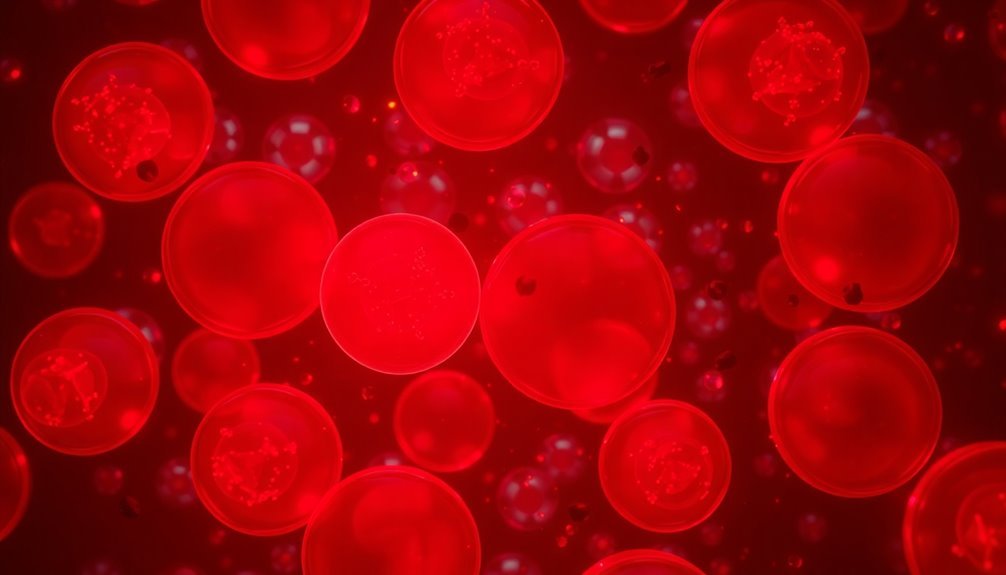
Your body's free radical defense systems get a significant boost from red light therapy through enhanced antioxidant enzyme production.
You'll experience improved cellular protection as the light triggers defense pathways that neutralize harmful free radicals and reduce oxidative stress.
The therapy's ability to strengthen these natural defense mechanisms helps prevent oxidative damage while supporting your cells' overall health and function.
The increased ATP production levels from red light therapy help power these critical antioxidant defense systems more effectively.
Antioxidant Enzyme Production
When examining cellular defense mechanisms, red light therapy demonstrates remarkable effects on antioxidant enzyme production and free radical defense systems. Your cells respond to red light exposure by reducing reactive oxygen species (ROS) accumulation, which creates a healthier cellular environment. Research shows that salt tolerance improves significantly under these light conditions.
This reduction in oxidative stress is evident through decreased activities of key antioxidant enzymes like superoxide dismutase (SOD) and peroxidase (POD).
You'll notice that red light therapy differs from blue and far-red light in several important ways. While blue light typically increases antioxidant enzyme activities, indicating higher oxidative stress, red light does the opposite by lowering these enzyme levels. This suggests your cells aren't fighting as hard against oxidative damage when exposed to red light.
Here are three key benefits you'll get from red light's effect on antioxidant production:
- Lower malondialdehyde (MDA) content, indicating reduced cell membrane damage
- Decreased proline levels, showing better cellular water balance
- Reduced need for antioxidant enzyme production, suggesting less cellular stress
These effects demonstrate how red light therapy helps maintain cellular health through improved oxidative balance.
Cellular Defense Pathways
Cells deploy sophisticated defense mechanisms when exposed to red light therapy, leading to enhanced protection against harmful free radicals. When you undergo red light therapy, it triggers a cascade of cellular responses that strengthen your body's natural defense systems. Your cells' mitochondria become more efficient at producing ATP, which powers essential protective functions throughout your body.
The therapy works by improving your electron transport chain's performance, particularly by helping dissociate nitric oxide from cytochrome C oxidase. This process isn't just about energy production – it's a vital part of your cellular defense strategy. As your cells generate more ATP, they're better equipped to fight inflammation and repair damage.
You'll benefit from enhanced cellular resilience as red light therapy activates stress response mechanisms that protect against oxidative damage. These defense pathways don't just guard your cells; they actively promote healing and tissue repair.
Whether you're dealing with skin conditions like psoriasis or acne, or looking to reduce inflammation, your cellular defense systems become more robust. The therapy's ability to boost mitochondrial function means you're strengthening your body's natural protective capabilities from the inside out.
Oxidative Damage Prevention
Through the powerful process of red light therapy, your body develops enhanced defenses against oxidative damage and harmful free radicals. When red light penetrates your skin, it activates your mitochondria, boosting cellular energy production while simultaneously managing oxidative stress. This natural defense mechanism helps protect your cells from damage and supports your body's healing processes.
Your body's antioxidant systems get a significant boost from red light therapy, helping you fight off the damaging effects of free radicals more effectively. The therapy stimulates protective mechanisms within your cells, reducing inflammation and supporting tissue repair.
You'll find that regular sessions can improve your overall wellness while protecting your brain and skin health.
Here's how red light therapy strengthens your oxidative damage defense:
- Activates your mitochondria to produce more ATP, giving your cells the energy they need to fight oxidative stress
- Upregulates your body's natural antioxidant production, creating a stronger defense against free radicals
- Reduces harmful reactive oxygen species (ROS) in your cells, preventing cellular damage and supporting faster recovery
Combined with a healthy diet and lifestyle choices, you'll maximize your body's natural ability to prevent oxidative damage through red light therapy.
Frequently Asked Questions
Can Red Light Therapy Help With Seasonal Affective Disorder (Sad)?
Yes, red light therapy can help with your SAD symptoms by improving your mood, boosting energy levels, and regulating sleep patterns. It's promising, but you should consult your healthcare provider before starting treatment.
How Long Do Cellular Energy Benefits Last After a Session?
You'll notice immediate energy benefits after a session, but they typically diminish within 24-48 hours. That's why you need regular sessions to maintain the cellular energy boost and sustained benefits.
Does Red Light Therapy Work Through Clothing or Bandages?
You'll get the best results applying red light directly to bare skin. While light can penetrate thin, light-colored fabrics, clothing and bandages greatly reduce effectiveness – blocking up to 75% of the therapeutic light energy.
Can Red Light Therapy Interfere With Prescription Medications?
Yes, red light therapy can interfere with certain medications, especially those that increase skin sensitivity. You'll need to consult your doctor before starting treatment, as some medications may cause adverse reactions when combined with light therapy.
What's the Minimum Effective Distance Between Light Device and Skin?
You'll want to keep your red light device at least 6 inches from your skin for facial treatments and 8-12 inches for body areas. The exact distance depends on your device's intensity and your skin's sensitivity.
In Summary
You're now equipped to harness red light's powerful cellular benefits. By understanding how it stimulates nitric oxide release, boosts ATP production, and enhances mitochondrial function, you'll make informed decisions about using this therapy. Whether you're an athlete seeking recovery or someone wanting better energy levels, red light therapy can strengthen your cellular metabolism and free radical defenses, ultimately supporting your overall health and vigor.

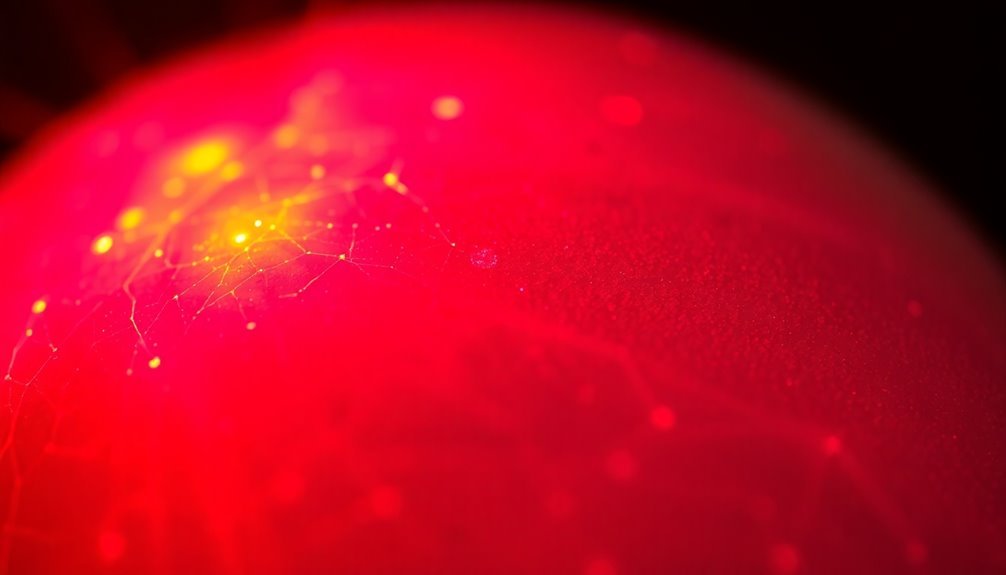



Leave a Reply